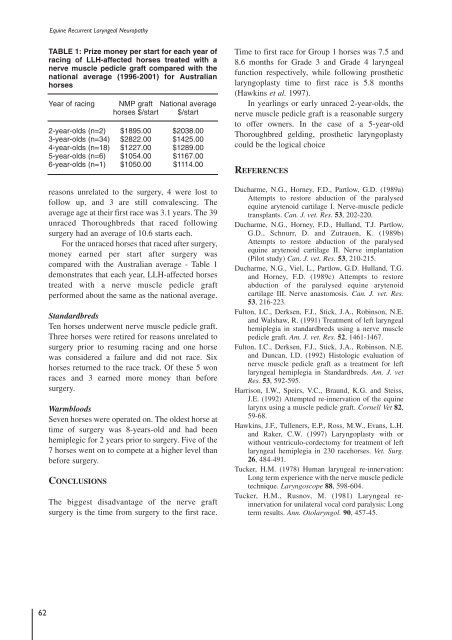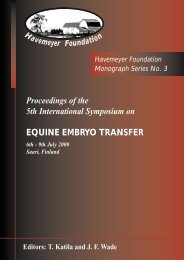Proceedings of a Workshop on - The Havemeyer Foundation
Proceedings of a Workshop on - The Havemeyer Foundation
Proceedings of a Workshop on - The Havemeyer Foundation
You also want an ePaper? Increase the reach of your titles
YUMPU automatically turns print PDFs into web optimized ePapers that Google loves.
Equine Recurrent Laryngeal Neuropathy<br />
TABLE 1: Prize m<strong>on</strong>ey per start for each year <str<strong>on</strong>g>of</str<strong>on</strong>g><br />
racing <str<strong>on</strong>g>of</str<strong>on</strong>g> LLH-affected horses treated with a<br />
nerve muscle pedicle graft compared with the<br />
nati<strong>on</strong>al average (1996-2001) for Australian<br />
horses<br />
Year <str<strong>on</strong>g>of</str<strong>on</strong>g> racing<br />
reas<strong>on</strong>s unrelated to the surgery, 4 were lost to<br />
follow up, and 3 are still c<strong>on</strong>valescing. <strong>The</strong><br />
average age at their first race was 3.1 years. <strong>The</strong> 39<br />
unraced Thoroughbreds that raced following<br />
surgery had an average <str<strong>on</strong>g>of</str<strong>on</strong>g> 10.6 starts each.<br />
For the unraced horses that raced after surgery,<br />
m<strong>on</strong>ey earned per start after surgery was<br />
compared with the Australian average - Table 1<br />
dem<strong>on</strong>strates that each year, LLH-affected horses<br />
treated with a nerve muscle pedicle graft<br />
performed about the same as the nati<strong>on</strong>al average.<br />
Standardbreds<br />
Ten horses underwent nerve muscle pedicle graft.<br />
Three horses were retired for reas<strong>on</strong>s unrelated to<br />
surgery prior to resuming racing and <strong>on</strong>e horse<br />
was c<strong>on</strong>sidered a failure and did not race. Six<br />
horses returned to the race track. Of these 5 w<strong>on</strong><br />
races and 3 earned more m<strong>on</strong>ey than before<br />
surgery.<br />
Warmbloods<br />
Seven horses were operated <strong>on</strong>. <strong>The</strong> oldest horse at<br />
time <str<strong>on</strong>g>of</str<strong>on</strong>g> surgery was 8-years-old and had been<br />
hemiplegic for 2 years prior to surgery. Five <str<strong>on</strong>g>of</str<strong>on</strong>g> the<br />
7 horses went <strong>on</strong> to compete at a higher level than<br />
before surgery.<br />
CONCLUSIONS<br />
NMP graft Nati<strong>on</strong>al average<br />
horses $/start $/start<br />
2-year-olds (n=2) $1895.00 $2038.00<br />
3-year-olds (n=34) $2822.00 $1425.00<br />
4-year-olds (n=18) $1227.00 $1289.00<br />
5-year-olds (n=6) $1054.00 $1167.00<br />
6-year-olds (n=1) $1050.00 $1114.00<br />
<strong>The</strong> biggest disadvantage <str<strong>on</strong>g>of</str<strong>on</strong>g> the nerve graft<br />
surgery is the time from surgery to the first race.<br />
Time to first race for Group 1 horses was 7.5 and<br />
8.6 m<strong>on</strong>ths for Grade 3 and Grade 4 laryngeal<br />
functi<strong>on</strong> respectively, while following prosthetic<br />
laryngoplasty time to first race is 5.8 m<strong>on</strong>ths<br />
(Hawkins et al. 1997).<br />
In yearlings or early unraced 2-year-olds, the<br />
nerve muscle pedicle graft is a reas<strong>on</strong>able surgery<br />
to <str<strong>on</strong>g>of</str<strong>on</strong>g>fer owners. In the case <str<strong>on</strong>g>of</str<strong>on</strong>g> a 5-year-old<br />
Thoroughbred gelding, prosthetic laryngoplasty<br />
could be the logical choice<br />
REFERENCES<br />
Ducharme, N.G., Horney, F.D., Partlow, G.D. (1989a)<br />
Attempts to restore abducti<strong>on</strong> <str<strong>on</strong>g>of</str<strong>on</strong>g> the paralysed<br />
equine arytenoid cartilage I. Nerve-muscle pedicle<br />
transplants. Can. J. vet. Res. 53, 202-220.<br />
Ducharme, N.G., Horney, F.D., Hulland, T.J. Partlow,<br />
G.D., Schnurr, D. and Zutrauen, K. (1989b)<br />
Attempts to restore abducti<strong>on</strong> <str<strong>on</strong>g>of</str<strong>on</strong>g> the paralysed<br />
equine arytenoid cartilage II. Nerve implantati<strong>on</strong><br />
(Pilot study) Can. J. vet. Res. 53, 210-215.<br />
Ducharme, N.G., Viel, L., Partlow, G.D. Hulland, T.G.<br />
and Horney, F.D. (1989c) Attempts to restore<br />
abducti<strong>on</strong> <str<strong>on</strong>g>of</str<strong>on</strong>g> the paralysed equine arytenoid<br />
cartilage III. Nerve anastomosis. Can. J. vet. Res.<br />
53, 216-223.<br />
Fult<strong>on</strong>, I.C., Derksen, F.J., Stick, J.A., Robins<strong>on</strong>, N.E.<br />
and Walshaw, R. (1991) Treatment <str<strong>on</strong>g>of</str<strong>on</strong>g> left laryngeal<br />
hemiplegia in standardbreds using a nerve muscle<br />
pedicle graft. Am. J. vet. Res. 52, 1461-1467.<br />
Fult<strong>on</strong>, I.C., Derksen, F.J., Stick, J.A., Robins<strong>on</strong>, N.E.<br />
and Duncan, I.D. (1992) Histologic evaluati<strong>on</strong> <str<strong>on</strong>g>of</str<strong>on</strong>g><br />
nerve muscle pedicle graft as a treatment for left<br />
laryngeal hemiplegia in Standardbreds. Am. J. vet<br />
Res. 53, 592-595.<br />
Harris<strong>on</strong>, I.W., Speirs, V.C., Braund, K.G. and Steiss,<br />
J.E. (1992) Attempted re-innervati<strong>on</strong> <str<strong>on</strong>g>of</str<strong>on</strong>g> the equine<br />
larynx using a muscle pedicle graft. Cornell Vet 82,<br />
59-68.<br />
Hawkins, J.F., Tulleners, E.P., Ross, M.W., Evans, L.H.<br />
and Raker, C.W. (1997) Laryngoplasty with or<br />
without ventriculo-cordectomy for treatment <str<strong>on</strong>g>of</str<strong>on</strong>g> left<br />
laryngeal hemiplegia in 230 racehorses. Vet. Surg.<br />
26, 484-491.<br />
Tucker, H.M. (1978) Human laryngeal re-innervati<strong>on</strong>:<br />
L<strong>on</strong>g term experience with the nerve muscle pedicle<br />
technique. Laryngoscope 88, 598-604.<br />
Tucker, H.M., Rusnov, M. (1981) Laryngeal reinnervati<strong>on</strong><br />
for unilateral vocal cord paralysis: L<strong>on</strong>g<br />
term results. Ann. Otolaryngol. 90, 457-45.<br />
62








